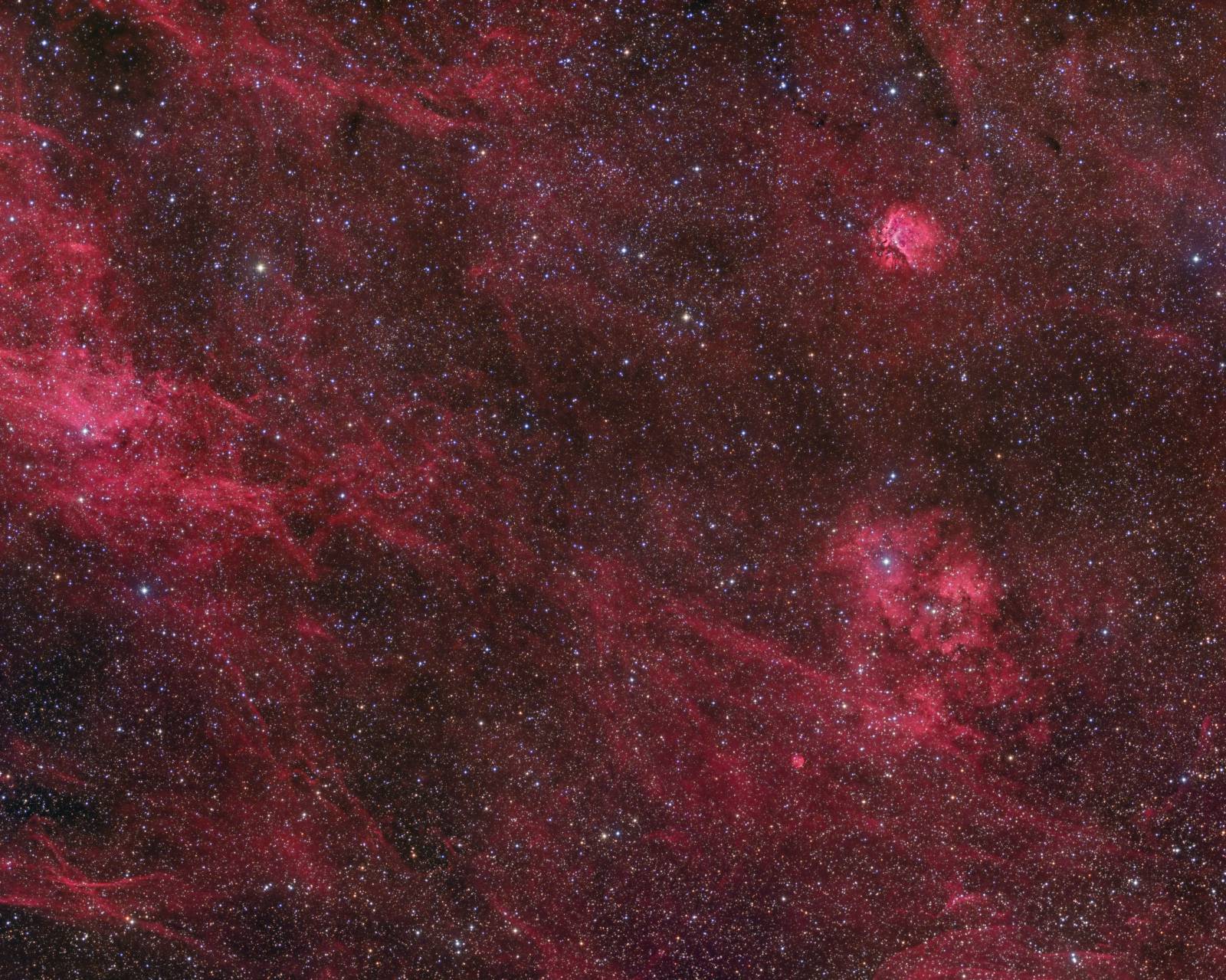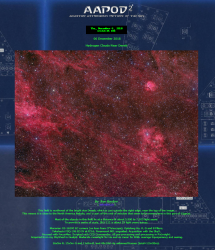Sharpless 112, 115 and 116 and LBN 325 and 326
 Click image for full size version
Click image for full size version
August 24, 2017, AAPOD, Dec. 6, 2018
 There is so much going on in this image! This field is northwest of the bright star Deneb, which is just outside the right edge, near the top of the image. This means it is close to the North America Nebula, and is part of the web of nebulae that seem to be everywhere in this part of Cygnus. Sh2-112 and Sh2-115 are the main objects at upper and lower right in the image, respecitively. The small bright patch to the lower left of Sh2-115 is Sh2-116. The left side of the image is dominated by LBN 326 and a part of LBN 325. The “braided” structure at lower left is made up LBN 375 and LBN 376. The are many more members of the Lynd’s Dark Nebulae (LBN) and Lynd’s Bright Nebulae (LDN)catalogues in the image.
There is so much going on in this image! This field is northwest of the bright star Deneb, which is just outside the right edge, near the top of the image. This means it is close to the North America Nebula, and is part of the web of nebulae that seem to be everywhere in this part of Cygnus. Sh2-112 and Sh2-115 are the main objects at upper and lower right in the image, respecitively. The small bright patch to the lower left of Sh2-115 is Sh2-116. The left side of the image is dominated by LBN 326 and a part of LBN 325. The “braided” structure at lower left is made up LBN 375 and LBN 376. The are many more members of the Lynd’s Dark Nebulae (LBN) and Lynd’s Bright Nebulae (LDN)catalogues in the image.
Most of the objects in this field lie at a distance of about 5,500 to 7,500 light years. To provide a sense of scale, Sh2-112 is about 25 light years across.
Tekkies:
Moravian G3-16200 EC camera (on loan from O’Telescope), Optolong Ha, R, G and B filters, Takahashi FSQ-106 ED IV at f/3.6, Paramount MX, unguided. Acquisition with the SkyX, focused with FocusMax. Scripted with CCD Commander. All pre-processing and processing in PixInsight. Acquired from my SkyShed in Guelph. Moderate moonlight for Ha and no moon for RGB. average transparency and seeing.
16x5m R, 15x5m G and 11x5m B, and 48x10m Ha unbinned frames (total=11hr30m).
Pre-Processing
The BatchPreProcessing script was used to perform calibration, cosmetic correction and registration of all frames. Blink and SubframeSelector were used to identify the best single exposure for each filter. LocalNormalization and ImageIntegration were applied using the best frames as reference frames. DrizzleIntegration was used to make the channel masters. During ImageIntegration and DrizzleIntegration, the local normalization files were used. The high large-scale removal tool was used in ImageIntegration.
NB-RGB Creation
Creation and cleanup: The R, G, B and Ha masters were cropped to remove edge artifacts. DynamicBackgroundExtraction was applied to each master. R, G and B were combined to make an RGB image which was processed with PhotometricColorCalibration, using the dark region at lower left as the background reference.
Combining Ha and RGB data: The NBRGBCombination script was run with default settings using Ha for red narrowband. The script was run a second time adding Ha into the Blue channel with a scale setting of 0.01. The two versions were blended using a mask to protectd background and stars. PhotometricColorCalibratin was applied, using the dark region at lower left as the background reference.
Linear Noise Reduction: MultiscaleLinearTransform was used to reduce noise in the NB-RGB image. The linear mask feature was used to protect bright stars and brighter areas of the nebulae. Layer settings for threshold and strength: Layer 1: 4.0 0.75 Layer 2: 3.0, 0.65 Layer 3: 2., 0.41 Layer 4: 1.0, 0.25 Layer 5: 0.5, 0.1.
Stretching: HistogramTransformation was applied to the NB-RGB image to make a pleasing, bright image.
Synthetic Luminance:
Creation and cleanup of SynthL: The linear Ha,R, G and B masters were combined using the ImageIntegration tool (average, additive with scaling, noise evaluation, iterative K-sigma / biweight midvariance, no pixel rejection).
Deconvolution: A star mask was made to use as a local deringing support image. A copy of the image was stretched to use as a range mask. Deconvolution was applied (50 iterations, regularized Richardson-Lucy, external PSF made using DynamicPSF tool with about 30 stars).
Linear Noise Reduction: MultiscaleLinearTransform was used to reduce noise in the background areas of the SynthL image. The linear mask feature was used to protect bright stars and brighter areas of the nebulae. Layer settings for threshold and strength: Layer 1: 4.0 0.65 Layer 2: 3.0, 0.5 Layer 3: 2., 0.3 Layer 4: 1.0, 0.1.
Stretching: HistogramTransformation was applied to the SynthL to make a pleasing, bright image.
Noise Reduction and Re-Stretch: TGVDenoise was applied in Lab mode with 300 iterations with a range mask used to protect high signal areas. This was followed by a HistogramTransformation to raise the black point (but with no clipping).
Combining SynthL with NB-RGB:
The processed SynthL was applied to the NB-RGB image using LRGBCombine.
Additional Processing
Contrast Enhancement: HDRMultiscaleTransformation was applied twice to the brightest patches of nebulae (median, scales of 6 and 4) using a mask to protect stars and fainter nebulosity. The contrast was boosted with LocalHistogramEqualization (max contrast of 1.5, scale 50, strength 0.75) using the same mask to protect background and stars. The mask was made by making a very blurred range mask with the RangeSelection tool and a star mask with the StarMask tool, and then using PixelMath to subtract the star mask from the range mask.
Final Steps: MultiscaleLinearTransform was used to sharpen the structures in the bright parts of the nebulae (layers 2-4 at 0.05). Background, nebula and star brightness, contrast and saturation were adjusted in several iterations using Curves with masks as required. Stars were reduced in size using the Morphological Selection mode of the MorphologicalTransformation tool. The image was rescaled (downsampled x2) back to the original image scale.
Image scale is about 3.2 arcsec per pixel for this camera/telescope combination.






Leave A Comment